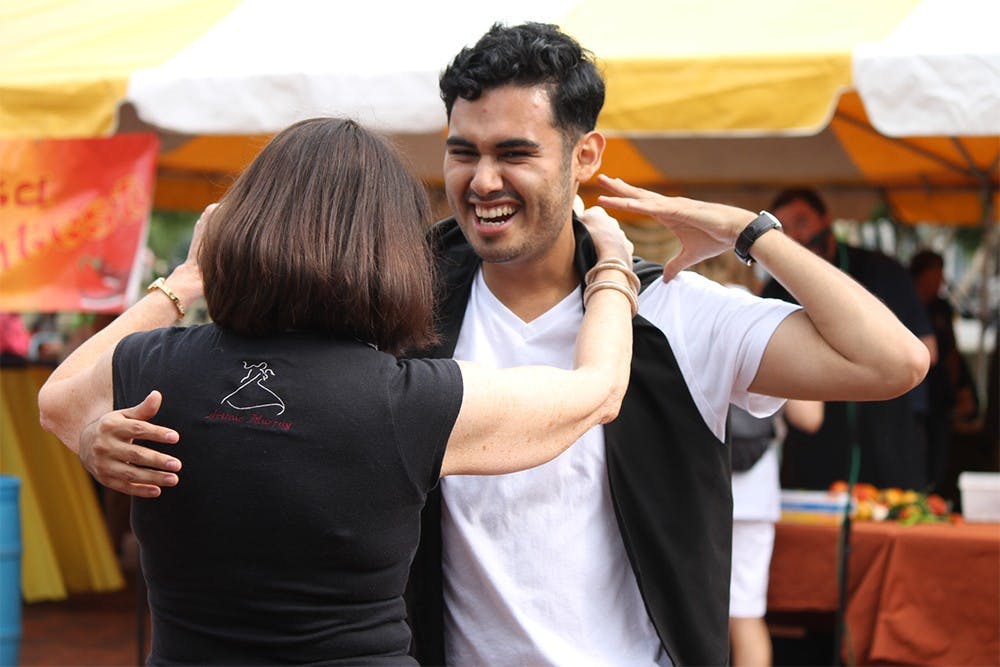He clears his mind and thinks to himself:
Listen to the beat.
Right, left, right. Gabriel Escobedo’s feet follow salsa’s three-step pattern. The same movements he learned in his childhood living room. The dance he danced at his cousin Danny’s wedding. And that time with the pretty girls from St. Matthew’s Catholic Church in high school. He moves his body to the beat. By now, the steps are ingrained in him.
The song, “El Cantante,” cuts through the noise of Bloomington’s Farmers’ Market.
“Y canto a la vida / De risas y penas”
(And I sing to life / To laughter and penalties)
Gabriel and his partner dance through the street. When he’s dancing, the world around him disappears. He forgets the stress from his doctoral research with IU’s Anthropology Department and classes with the Arthur Murray Dance Studio. The adolescent memories of feeling lost, out of touch with his Mexican-American heritage, vanish.
All that’s left is his partner and the music.
Gabriel has met two kinds of dancers. There are the technical ones, who only focus on their appearance. And then there are people like him, who just go with the music.
He lets himself move to the rhythm, focusing on his partner. When he pulls her close, he feels if she’s scared or comfortable. He senses whether she wants to dominate or be led.
They find a balance through their movements, pushing and pulling to the beat.
“Que hoy han venido a escuchar / Lo mejor, del repertorio / A ustedes voy a brindar”
(We now have come to listen / The best, the repertoire / To you, I will give)
To him, it feels like the moment will last forever. He feels greedy, always wanting more dance. More music. He raises his right hand, spinning his partner underneath, never breaking the three-step pattern.
He tells himself to never think too hard.
Lose control. Feel the music.
***
When he was seven, his parents stopped teaching him Spanish. It was for his protection, he said. He could probably get a better job if no one thought he was an immigrant.
The Escobedos were second-generation Mexican-Americans living in Arlington, Texas. Gabriel and his extended family all lived under one roof. His aunts, uncles, cousins, grandparents and parents watched telenovelas together on the TV in his living room.
One night his grandmother’s yellow dog, Precious, jumped on Gabriel’s face, licking him. Gabriel wrestled with the excited dog, laughing, and carrying her around the room. His relatives watched him move around.
“He’s dancing! He’s dancing!” his grandmother said.
Dancing? Gabriel thought about the word. What does that mean?
“After that, my mother and my aunts or whoever would grab me and try and teach me how to dance,” he said.
He learned salsa on the street — en la calle. At parties, in the park, in his living room. Wherever people and music met, Gabriel tried to dance. But he didn’t speak Spanish. No one except for his family thought he was Latino. When his friends would ask him something in Spanish, Gabriel would stay silent. He picked up bits and pieces of slang but could never completely express what he wanted to say.
“It was like the tongue you were meant to have was taken away from me,” he said.
To show everyone how he felt, he would dance with them.
***
Gabriel dips his partner.
“De momentos malos / Y de cosas buenas / No hay tiempo para tristezas / Vamos cantante comienza!”
(In bad times / And good things / No time for sadness / Let the singer continue!)
When he came to IU last year, Gabriel started a nonprofit program, Paso a Paso, where he taught people to dance. He hosted the first event in the Neal-Marshall Black Cultural Center for more than 60 attendees. He even developed a series of non-verbal cues for sitting and standing salsa partners to help his friend in a wheelchair navigate the dance floor.
The world around him comes back into motion. He hears the sounds of the market — the shoppers haggling, the kids playing in the grass. He remembers his growing list of responsibilities. He wants to find ways to show how dance is more than just movements.
He said, for him, it creates dialogue.
As the song ends, Gabriel smiles at his partner.
“Thank you for the dance,” he says, moving away.
The next song begins as he holds his hands out for someone new, already moving to the beat.






